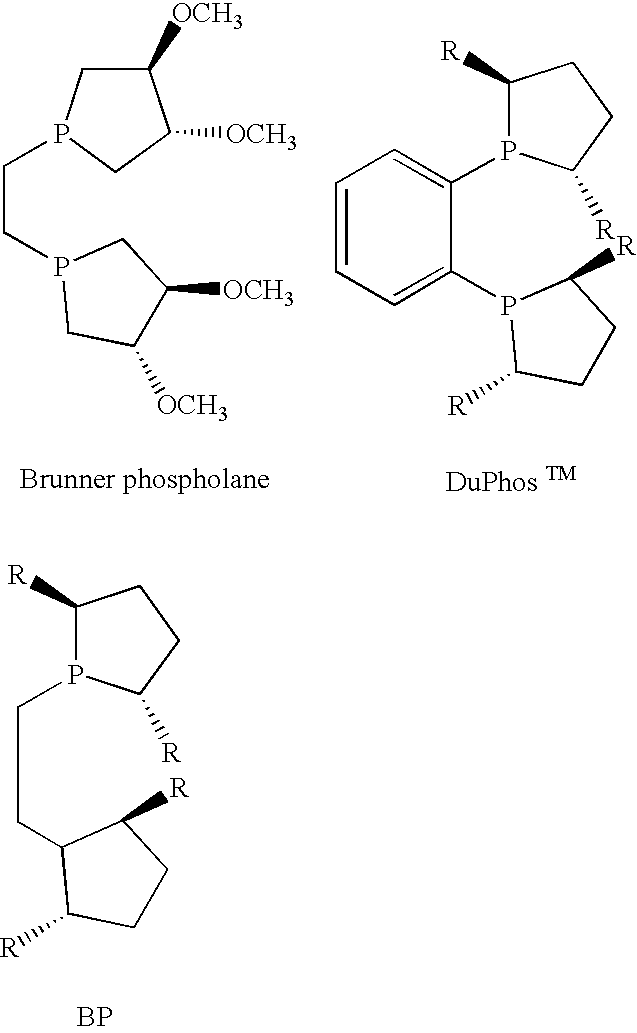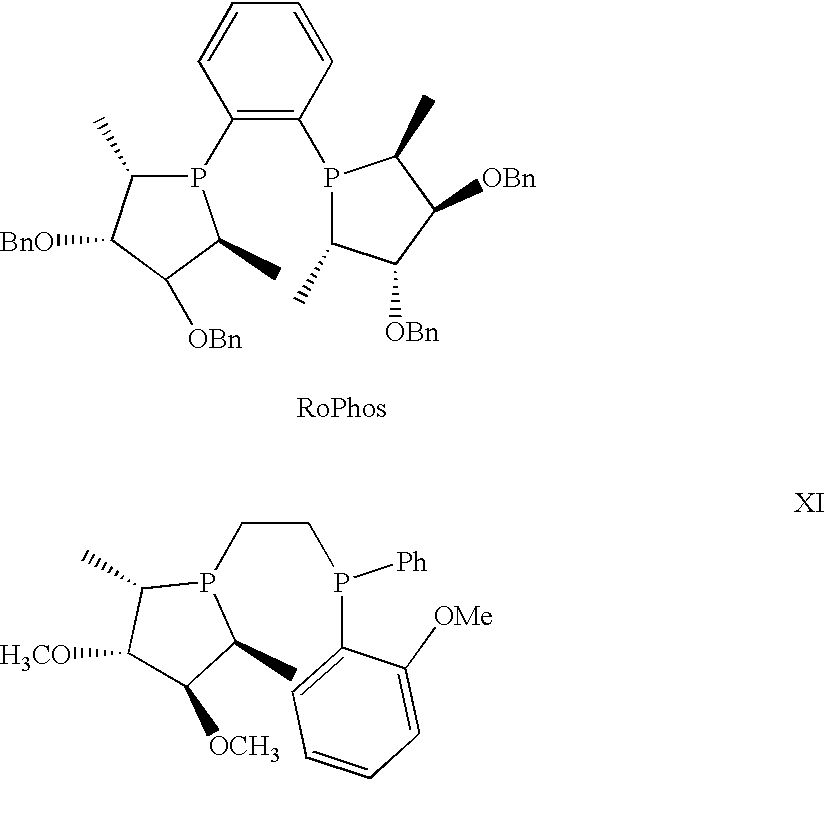Asymmetric catalysis based on chiral phospholanes and hydroxyl phospholanes
a technology of hydroxyl phospholanes and asymmetric catalysis, which is applied in the direction of catalytic reactions, group 5/15 element organic compounds, indium organic compounds, etc., can solve the problems of poor enantioselectivities, few chiral ligands or motifs are efficient for the synthesis of commercially useful chiral molecules in industry, and ligands are not effective for some other asymmetric reactions. , to achieve the effect o
- Summary
- Abstract
- Description
- Claims
- Application Information
AI Technical Summary
Benefits of technology
Problems solved by technology
Method used
Image
Examples
example 1
Phosphine 19
[0114] To a stirred solution of phenylphosphine (0.44 g, 4.0 mmol) in THF (80 mL), n-BuLi (1.6 M n-hexane solution, 2.5 mL, 4.0 mmol) was added dropwise via a syringe at -78.degree. C. The resulting pale yellow solution was stirred for further 2 h at room temperature. After cooling the mixture to -78.degree. C., cyclic sulfate 9 (1.01 g, 4.0 mmol) in THF (40 mL) was added over 10 min. The resulting yellow solution was warmed to room temperature and stirred for 4 h. After cooling to -78.degree. C., n-BuLi (1.6 M solution in n-hexane, 2.5 mL, 4.0 mmol) was added, and the reaction mixture was stirred for an additional 20 h at room temperature. The color of the reaction mixture changed from orange yellow to red, and then decolorized to colorless. After removal of the solvent under reduced pressure, the residue was dissolved in 40 mL of ethyl ether, and 30 mL of brine was added. The aqueous layer was then washed with 3.times.30 mL ethyl ether. The combined organic layers were...
example 2
[0115] Phosphine 19 obtained above was dissolved in 50 mL methanol and 2 mL of water. To this solution, 0.05 mL of methanesulfonic acid was added and the resulting mixture was refluxing for 10 h. The solvent was removed under reduced pressure and the residue was dissolved in 50 mL of methylene chloride. 30 mL of aq NaHCO.sub.3 was added and the two layers were separated. The aqueous layer was washed with 3.times.40 mL of methylene chloride. The combined organic layers were dried over Na.sub.2SO.sub.4 and concentrated to give a white solid, compound 1.
example 3
Phosphine 21
[0116] To a stirred solution of phenylphosphine (220.2 g, 2.0 mmol) in THF (50 mL), n-BuLi (1.6 M n-hexane solution, 1.25 mL, 2.0 mmol) was added dropwise via a syringe at -78.degree. C. Then the resulting yellow solution was stirred for further 2 h at room temperature. After cooling the mixture to -78.degree. C., cyclic sulfate 20 (0.78 g, 2.0 mmol) in THF (30 mL) was added over 10 min. The resulting brown solution was warmed to room temperature and stirred for 4 h. After cooling to -78.degree. C., n-BuLi (1.6 M solution in n-hexane, 1.25 mL, 2.0 mmol) was added and the reaction mixture was stirred for an additional 20 h at room temperature. Then BH.sub.3-THF complex (1 M solution in THF, 3.0 mL, 3.0 mmol) was added at 0.degree. C. After stirring overnight, the solvents were removed under reduced pressure. Water (30 mL) was added to the residue and the aqueous solution extracted with CH.sub.2Cl.sub.2 (3.times.40 mL). The combined organic layers were dried (Na.sub.2SO.su...
PUM
| Property | Measurement | Unit |
|---|---|---|
| optical purity | aaaaa | aaaaa |
| optical purity | aaaaa | aaaaa |
| optical purity | aaaaa | aaaaa |
Abstract
Description
Claims
Application Information
 Login to View More
Login to View More - R&D
- Intellectual Property
- Life Sciences
- Materials
- Tech Scout
- Unparalleled Data Quality
- Higher Quality Content
- 60% Fewer Hallucinations
Browse by: Latest US Patents, China's latest patents, Technical Efficacy Thesaurus, Application Domain, Technology Topic, Popular Technical Reports.
© 2025 PatSnap. All rights reserved.Legal|Privacy policy|Modern Slavery Act Transparency Statement|Sitemap|About US| Contact US: help@patsnap.com



